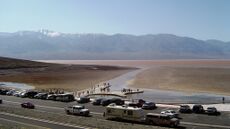Sink (geography)
Topic: Earth
 From HandWiki - Reading time: 2 min
From HandWiki - Reading time: 2 min
A geographic sink is a depression within an endorheic basin where water collects with no visible outlet. Instead of discharging, the collected water is lost due to evaporation and/or penetration (water sinking underground, e.g., to become groundwater in an aquifer). If the sink has karstic terrain, water will sink at a higher rate than the surface evaporation, and conversely if the lakebed or sink bed has a layer of soil that is largely impervious to water (hardpan), evaporation will predominate. Since dry lakes in sinks with hardpan have little penetration, they require more severe aridity/heat to eliminate collected water at a comparable rate as for a similar sink with appreciable penetration.
Depending on losses, precipitation, and inflow (e.g., a spring, a tributary, or flooding); the temporal result of a lake in a sink may be a persistent lake, an intermittent lake, a playa lake (temporarily covered with water), or an ephemeral lake.
List of geographic sinks
- Mediterranean Sink during the Messinian Event
- Red Sea when blocked off by the Perim volcano
- Africa: Afar Depression
- USA: Carson Sink
- USA: Humboldt Sink
- USA: Quinn River Sink
- USA: Salton Sink
See also
References
This article does not cite any external source. HandWiki requires at least one external source. See citing external sources. (November 2011) (Learn how and when to remove this template message) |
 KSF
KSF
